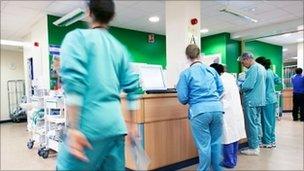Staff census shows NHS workforce hits 1.4 million
- Published

There has been a big increase in the number of clinical staff in the NHS over the past 10 years
New figures show a huge growth in the number of staff working for the NHS in England over the past decade, particularly among managers.
By the end of September 2010, 1.4 million people worked for the health service in England.
But the NHS workforce census reveals numbers are beginning to decline as budgets are squeezed.
More jobs are likely to go when the government's reforms to the health service take hold.
In the decade to September 2010, the workforce survey shows that numbers grew in almost every category of NHS staff.
There were a quarter more GPs, an increase of more than 50% in the number of consultants and the number of qualified nurses was up by a fifth.
The number of managers has also climbed dramatically over the past ten years, to 41,962 - an increase of 66%.
But the census, carried out by the NHS Information Centre, also reveals that with the government's radical reforms to the NHS in England on the horizon, the number of managers has actually been falling in the past year.
In the year to September 2010, the number of managers fell by 2,770.
And provisional figures for December 2010 show that trend has continued, with a further management 1,143 posts lost.
Those figures also show a small decline in the total number of nurses, including practice and temporary staff, down by 0.9% in the year to September 2010.
Some experts believe that these figures could be the high water mark for the number of people employed by the NHS as the government's reforms take hold.
The Health Minister Simon Burns said the NHS was reducing bureaucracy and management costs.
"The latest census shows that the NHS has taken up the challenge to reduce management costs whilst the number of doctors and nurses has increased.
"Reducing bureaucracy is vital to modernising the NHS so that every penny saved can be reinvested into improving patient care and driving up quality.
"We have always been clear that efficiency savings must not impact adversely on patient care. Instead the size and shape of the workforce needs to change so that we have less bureaucrats and the right levels of clinical staff so that care can be brought closer to home for patients."
But the Shadow Health Secretary John Healey said the NHS in England now faced an uncertain future after years of investment.
"This will come to be seen as a high-point for the health service, at a time when many frontline staff are facing an uncertain future - and despite David Cameron's promise to protect the NHS.
"The findings also give lie to the claim that Labour was all about increasing and protecting management posts. The number of NHS managers has been falling since before the election while our investment in the health service over the previous decade saw over 150,000 extra clinical staff."
Cathy Warwick, general secretary of the Royal College of Midwives, welcomed the increase in midwife numbers but said an extra 4,000 posts are needed to cope with increased demand in England.
"What we are seeing is the tail-end of the previous government's policies to increase the number of midwives. My fear is that this may be a peak in numbers before the inevitable slide downwards as the financial pressures on the NHS start to bite.
"It is also clear when you look at the figures that the major part of the increase is driven by rising numbers in London. Other areas of the country are seeing tiny increases or even a fall.
"The RCM still believes that thousands more midwives are needed to cope with the historically high birthrate and the increasing complexity of births; all of which is putting pressure on maternity services and demanding more of midwives' time."
- Published10 February 2011
- Published23 February 2011
- Published16 January 2011